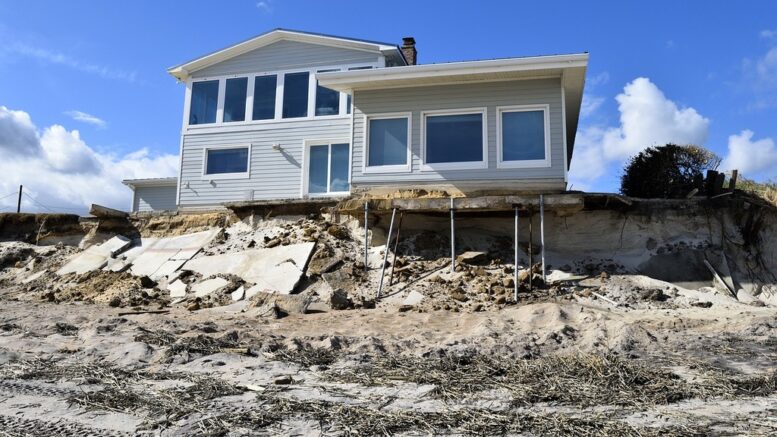By Chloe Smith
As sea levels rise, storm surges worsen and hurricanes become harsher, beach erosion is becoming an even greater threat for St. Johns County, and those who live along the coast. Even as new renourishment projects are planned to restore depleted beaches, some wonder if these plans will be enough to prevent the inevitable.
Dr. Veenstra, a professor at Flagler College with a Ph.D. in Environmental Science, Soil Science and Sustainable Agriculture, said that’s a problem that is facing beach-side communities more than ever.
“If we have more strong storms, we’re going to have more beach erosion, and so … when do we give up on this treadmill of just like keeping … trying to keep the beach in place?” she said. “That’s the question.”
According to the Florida Department of Environmental Protection, as of June 2022, there are five critically eroded areas — totaling up to 16.3 miles — in St. Johns County. These areas threaten private development, marine life, nesting, other wildlife habitats, or development and recreational interests.
One of the engineering solutions to this problem is beach renourishment, the process of adding additional sediment onto an eroding beach.
The U.S. Army Corps of Engineers is conducting a St. Johns County Shore Protection Project to mitigate the alarming amount of beach erosion on St. Augustine Beach.
Beginning in mid-July, the project expects to renourish the eroded shoreline between the southern limits of Anastasia State Park to a point 3.9 miles south of St. Augustine Inlet. The contractor will place approximately 800,000 cubic yards of sand — dredged from the federal navigation channel and St. Augustine Inlet ebb shoal — onto eroded areas. The cost-sharing will be 80.5% federal and 19.5% non-federal.
“It is a Band-Aid of real renourishment,” said Sea Turtle Hospital Program Manager at the Whitney Laboratory Catherine Eastman about the St. Johns County project. “It’s not a one-and-done. It’s a maintenance schedule.”
The renourishment cycle for the project is every five years. Since beach renourishment is an ongoing process, it oftentimes leads to higher costs over time and repeated disturbance of the surrounding environment.
“We are like just about to start a major project across the whole county, and so we’ll see how much we spend and then how long that lasts,” said Veenstra. “Do we have a big storm season this fall or not? I hope not, but if we do, it could easily take all of this.”
To determine the root cause of the beach erosion issue, it’s crucial to look at the Coastal Construction Control Line (CCCL), a program initiated by the Florida Legislature aiming to “protect the coastal system from improperly sited and designed structures that can destabilize or destroy the beach and dune system.”
It is a line of jurisdiction defining the landward limit of the Department of Environmental Protection’s authority to regulate construction. If a property is situated seaward of the CCCL, it risks causing beach erosion, destabilizing dunes, damaging upland properties, or interfering with public access.
“We have repeatedly in this county made the decision or given people permission to build seaward of that line, and closer to the ocean,” said Veenstra. “And so, we’ve given people permission to break our own rules, and those rules were in place to help prevent some of these issues.”
Summer Haven, the southeast St. Johns County community, is a perfect example. The area has been battling years of beach erosion and severe breaches due to storms. Now, it’s to the point where a series of houses can only be accessed by driving on the beach, as the road has been completely eroded.
“There’s no engineering solution at this point, and I think of that as kind of like a case study or kind of a model for something that we’re going to see more of in the future,” says Veenstra. “At some point, we’re just going to have to decide we can’t keep up with this. It’s too expensive to keep up with this.”
Beach renourishment will temporarily reduce the effects of erosion, but the solution is not exactly fit for the long haul. Past renourishment efforts, such as the multi-million-dollar Vilano Beach restoration project, have already proved this true for St. Johns County.
“We’re thinking short-sided… ten years, fifteen years,” said Eastman.
The most effective option would be to stop building properties on the beach altogether.
“The retreat, moving to higher and dryer, is like a long-term plan,” said Eastman. “But nobody in government is brave enough to say that time is now. Now it starts.”
76.5% of Florida’s population lives in coastal areas, according to the National Oceanic and Atmospheric Administration, so despite the benefits, moving inland is likely not a popular solution.
“The further we can build away from the beach, the better off we are,” said Veenstra. “But we also have to recognize that we’ve already done it. There are a lot of places that have already been built really, probably too close to the water line. And so, now we have to deal with that.”
To learn more about the St. Johns County Shore Protection Project, visit https://www.saj.usace.army.mil/StAugustineBeach/.



Be the first to comment on "County wrestles with beach erosion and renourishment as storms get stronger"